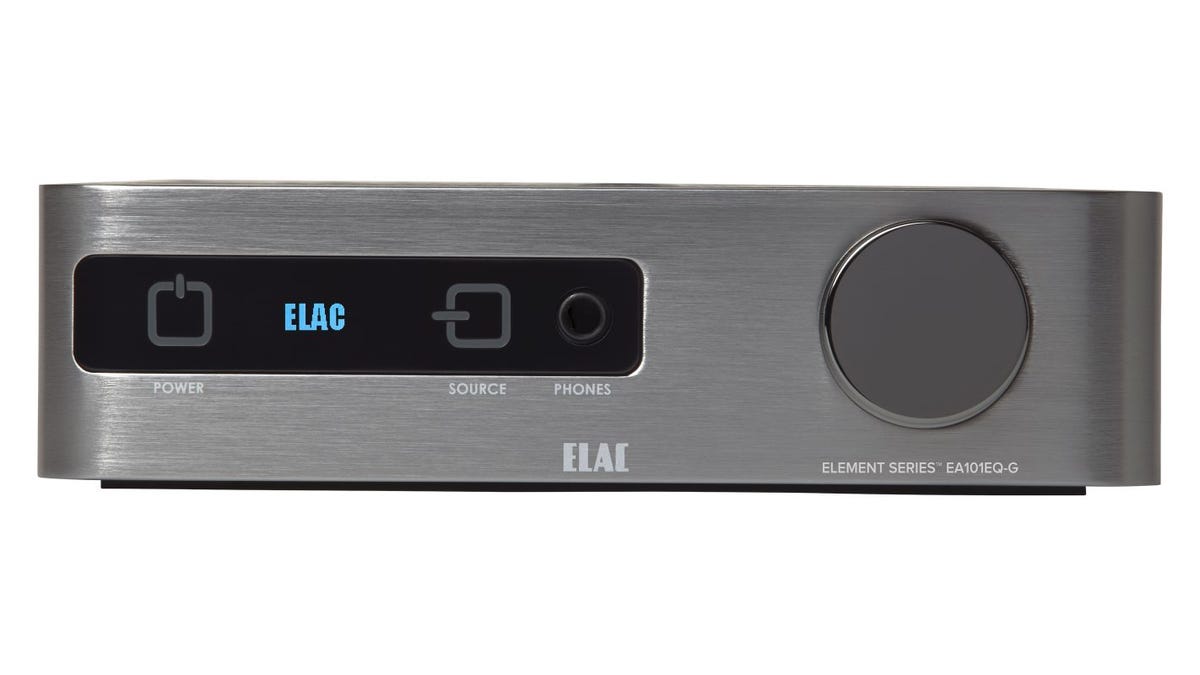Affordable audiophile bliss: ELAC speakers and their new little amplifier
The Audiophiliac reports on the ELAC Element amp, and finds joy with it teamed with ELAC's Uni-Fi UB5 speakers.

ELAC's speakers have been favorites here at CNET for a couple of years, so when I heard the company brought out a handsome little stereo amplifier I had to check it out. It was obvious from the get-go that rather than make just another integrated amp, ELAC engineers endowed the Element Series EA101EQ-G amp with a unique features set, including a multifunction app for not just the basics like volume, bass & treble, etc., but it also offers auto room correction, plus the option to blend a subwoofer with your main speakers via the app.
Build quality feels sturdy and the Element won't take up much space in your life, thanks to its dainty 8.25 x 12.25 inch (210x311mm) footprint.
The ELAC Element Series EA101EQ-G amp
The Element ($699, £629) amplifier section combines the best features of Class D and Class AB circuitry to deliver 80 watts per channel for 4-ohm speakers, and 40 watts per channel for 8-ohm speakers. Connectivity options include two stereo analog inputs, two optical, one coaxial, and one USB digital input, all with up to 192 kHz/24-bit resolution. You get a 6.3mm headphone jack, and for wireless operation there's aptX Bluetooth audio. The Element comes with a remote control.
Pairing the Element with ELAC's terrific Uni-Fi UB5 bookshelf speakers seemed like an obvious place to start, and indeed the sound was big and bold. All the things I like about the Uni-Fi UB5 speakers were in full force: near holographic imaging, substantial deep bass, lifelike midrange and clear highs. With Radiohead's "A Moon Shaped Pool" album, the Element/Uni-Fi UB5 sound was excellent, very transparent, with razor sharp imaging, and solid deep bass, even without a subwoofer! The speakers and Element together would make for a great affordable audiophile starter system.
Running the ELAC app on an Android phone (the iOS app isn't fully functional yet) in the CNET listening room with the Uni-Fi UB5 speakers and a Klipsch R-110SW subwoofer, the Element set the sub's volume much too low, so I manually turned it back up. Getting the sub volume wrong is a common failing with most AV receivers' auto speaker calibration systems, but they usually set the sub volume too high. The Element set it too low. The app's room correction and auto blend results will vary for each user; it may work miracles for you, or maybe not. Let your ears be the judges.
The ELAC Uni-Fi UB5 speakers
Then I took the Element home, so I could listen to it with my Magnepan .7 flat-panel speakers. Those speakers are harder to drive than the Uni-Fi UB5s, so I wanted to see how the Element would fare. My first impression was that the sound was fine; the Element had enough power on tap to make the .7 speakers dance. I know these speakers well, and over time I started to feel that the .7 speakers' clarity with the Element was lacking, the soundstage was constricted a bit, and dynamics were reigned-in.
To check that hunch I put the Element aside and hooked up my NAD C 316BEE stereo integrated amp. That did it; the .7 speakers' innate clarity, big soundstage and dynamics returned. The C 316BEE is rated at 40 watts per channel for 8-ohm speakers, same as the Element, but it's a lot less expensive, just $380/£199. I much preferred the C 316BEE's sound over the Element.
Still, the C 316BEE comes up short in features, it lacks digital inputs, Bluetooth, subwoofer output and room correction, etc. But it definitely sounded better driving the .7 speakers.
I also auditioned the Element with my AudioQuest NightOwl and Grado GH1 headphones, and liked what I heard.
Summing up, the ELAC Element is a decent little amp, and a natural partner for ELAC's terrific speakers, but I was less pleased with the amp's sound with more demanding speakers like the Magnepan .7s. As for the Element's generous feature set, it's likely to sway some buyers enough to take the plunge.

